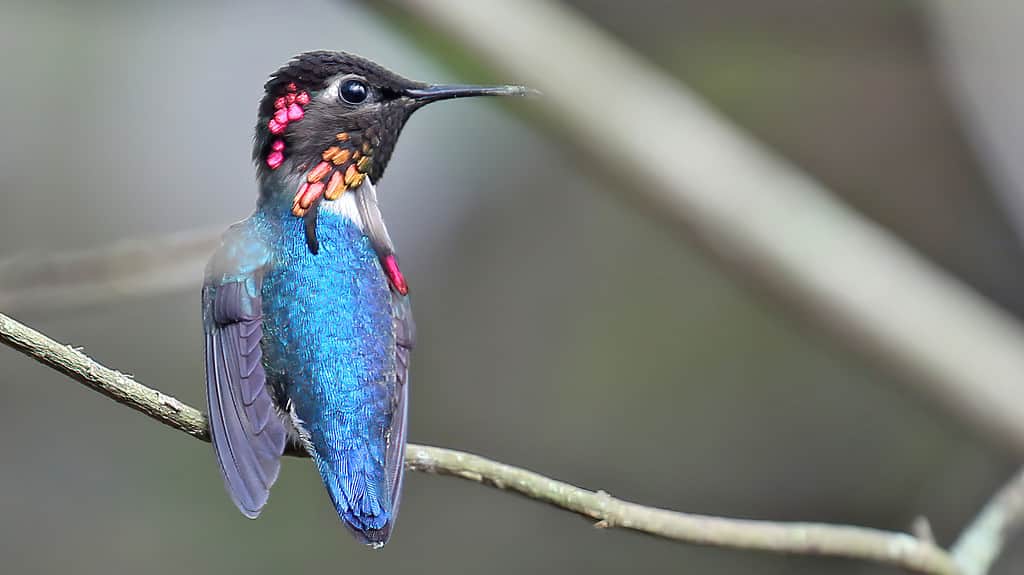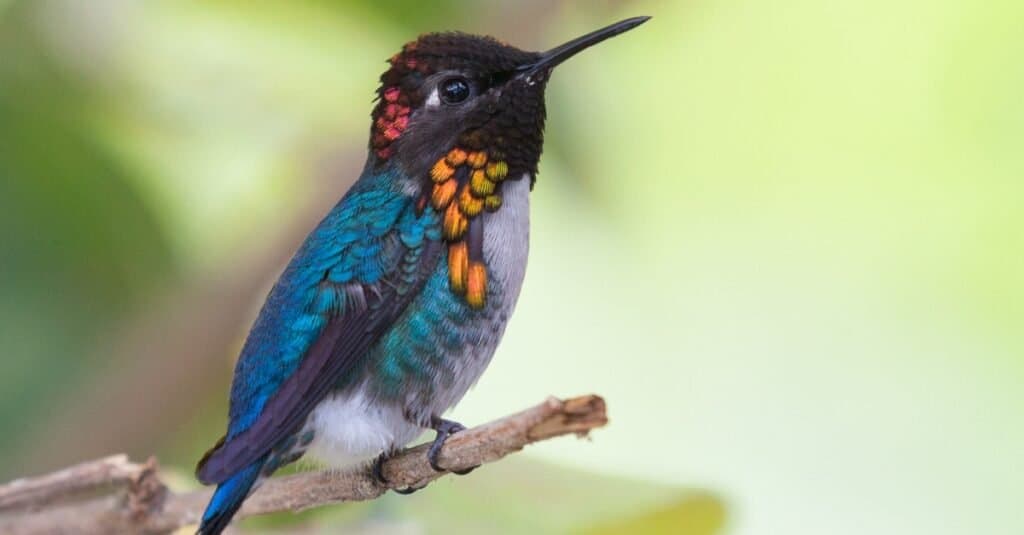There are over 330 species of hummingbirds throughout the world with beautiful colors and impressive flying abilities. Hummingbirds are small in size, but the bee hummingbird (Mellisuga helenae) is extra special — it is the smallest hummingbird in the world! Found only in Cuba, this bird is a true gem of the natural world with its iridescent feathers, tiny size, and lightning-fast flight. Let’s take a closer look at this miniature marvel!
Where Does the Bee Hummingbird Live?

Bee hummingbirds can visit up to 1,500 flowers per day.
©iStock.com/Manakin
This tiny hummingbird is endemic to Cuba, which means that this is the only place on earth where bee hummingbirds live! Bee hummingbirds live in fragmented populations across Cuba. They are particularly fond of dense forests by the sea and areas with lots of bushes. However, they can sometimes also be seen in mountain valleys, gardens, and swamps as well,
These teeny tiny birds typically hang out in flat, lowland areas, but they can be pretty hard to spot. If you’re lucky, you might be able to see one of these beauties as it dips its thin, pointed bill into a flower. These birds primarily eat nectar. There are 10 different plant species in Cuba that they feed from, although on occasion they also may eat spiders and insects. They may be small, but bee hummingbirds are ravenous animals. They eat nearly half their own body weight and consume more than eight times their mass in water each day!
When bee hummingbirds collect nectar, they often get a bit of pollen stuck on their bills and even on their faces and heads. This pollen falls off as they move and is transferred from flower to flower, making this bird very important for pollination and plant reproduction in Cuba. In fact, a bee hummingbird might visit 1,500 flowers in a single day!
What Does the Bee Hummingbird Look Like?

The bee hummingbird averages around two inches in length.
©iStock.com/epantha
Not only is the bee hummingbird the smallest hummingbird species in the world, but it is also the smallest species of bird on earth! This bird only grows to around 2.25 inches in length. Female bee hummingbirds are just slightly larger than males, but both are still incredibly tiny. They weigh even less than an American dime, coming in at just 0.056 to 0.067 ounces!
Male bee hummingbirds have iridescent blue feathers on their backs and a grayish-white coloring underneath. There are shiny green feathers on top of their heads and depending on the season, there can be fiery red feathers around their throats. During the mating season, male hummingbirds will have red or pink-colored feathers on their throats, chins, and heads. Females have iridescent bluish-green feathers with a pale gray underside. They also have white spots on the tips of their tails.
While hummingbirds typically have slender bodies, these birds are much rounder and some even have a plump appearance. Because of their unique shape and extraordinarily small size, bee hummingbirds are commonly mistaken for bees instead of birds!
In spite of their petite size, bee hummingbirds can beat their tiny wings very fast, around 80 times per second. When they are courting and trying to impress the females, males can beat their wings up to 200 times per second! These birds are also incredibly agile and can perform impressive aerial acrobatics. Not only can they fly straight, up, and down, but they also can fly backward and even upside down! In addition, these itty bitty hummingbirds can fly up to 25 to 30 miles per hour!
Baby Bee Hummingbirds
For much of the year, bee hummingbirds are solitary creatures and live on their own. However, from March to June male birds gather together for the breeding season in groups called leks. Males in a lek will sing to attract female bee hummingbirds. In addition, they also compete for females by flashing their colorful feathers and performing astonishing aerial dives that cause their tail feathers to produce unique sounds. One male hummingbird may mate with multiple females during one breeding season. However, only the female birds take care of the baby.
After mating, females find a suitable place to build their incredible small nests — they measure less than an inch in diameter! They make their teeny tiny nests with bark, lichen, and cobwebs, and line them with soft plant materials. Females lay two impossibly small eggs that are about the size of a garden pea or a coffee bean!
Baby bee hummingbirds hatch after about three weeks of incubation. When they emerge from their teeny tiny eggs, baby birds have no feathers and cannot see yet. However, they grow surprisingly fast. The babies form full feathers and leave the safety of their nest in around 18 to 24 days.
Conservation Status of Bee Hummingbirds
As you can imagine, being the smallest hummingbird in the world isn’t easy. Being so small makes these beautiful birds easy targets for larger predators. Bee hummingbirds are often targeted by bigger birds as well as spiders, wasps, praying mantises, frogs, rats, and mongooses. Many of these predators are not native to Cuba and were introduced to the islands by humans. In addition, these birds are very vulnerable to changes in climate as well as storms and suffer from habitat loss and deforestation. Their populations have declined enough that the bee hummingbird is now considered a near-threatened species.
Thank you for reading! Have some feedback for us? Contact the AZ Animals editorial team.








